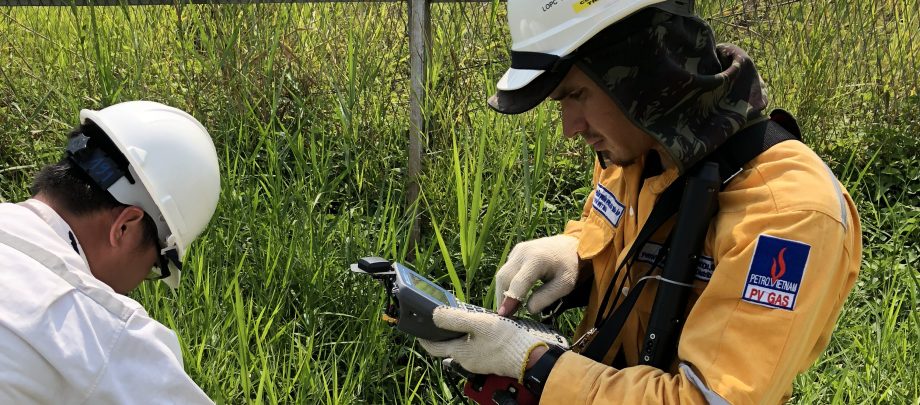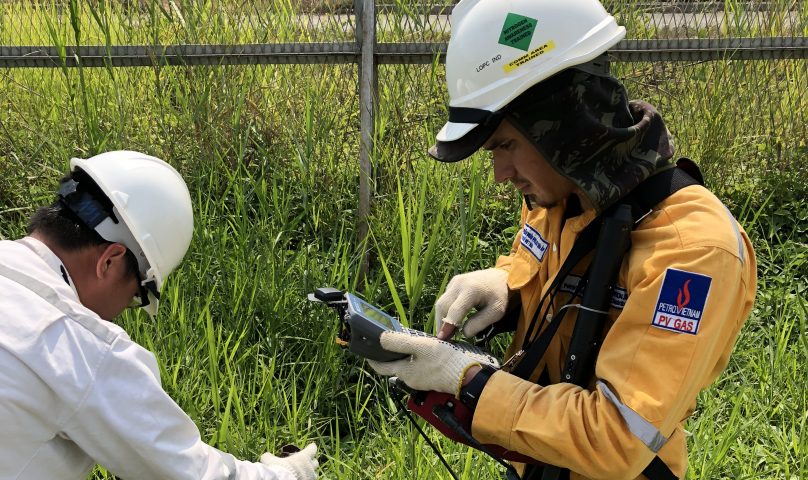
CPCL offer all types of pipeline direct surveys (ECDA) which assess external corrosion this includes CIPS, DCVG, DOC, PCM and AVG surveys.
We have extensive worldwide experience in this area and utilise cutting edge equipment and technology to provide a bespoke service to meet your requirements.
Pipeline Services
Close Interval Potential Survey technique is used to provide a detailed profile of the potential difference between the pipeline and the soil.
The CIPS ensures that a much greater sample of pipe-to-soil potential measurements are collected to provide a ‘continuous’ pipe-to-soil potential profile. This can be used to help determine the performance of the cathodic protection system including interaction effects, areas of low protection, interference or coating defects.
A key to successfully recording these potentials accurately is to install GPS synchronized Interrupters to the transformer-rectifiers to interrupt the cathodic protection current. The ON and OFF potentials are then recorded at regular intervals of 1-2 meter across the entire length of the pipeline route.
Stray current interaction from CP systems operated by third parties or other conditions may cause the pipe-to-soil potentials to be unstable, static data loggers are also used to provide a profile representative of the pipeline potential and allow further interpretation of the CIPS data.
Direct Current Voltage Gradient is specifically used to evaluate the coating condition on buried pipelines by locating coating defects and categorising them.
When direct current (DC) is applied to a pipeline, a voltage gradient is created in the soil due to the passage of current from the anode bed to the bare steel exposed at coating defects.
A digital or analogue voltmeter is used with a pair of saturated Copper/Copper Sulphate electrodes to locate the epicenter of a defect on the soil surface directly above its location.
To separate the DC signal from other DC sources (such as long line cells, telluric and other foreign CP systems) a Current Interrupter is inserted into the negative connection of the pipeline CP power source.
The magnitude of the voltage gradients is directly related to the current magnitude, the soil resistivity and the holiday size. The defect size correlates precisely with the gradient and on pipelines whereby many defects individual to the surface areas can be accurately estimated.
Pipeline current mapping enables the pipeline surveyor to identify ‘shorts’ caused by contact with other metallic structures and coating defects.
Traditional surveys measure the voltage potential of the pipe with respect to the earth around it to show that the pipe is protected against corrosion. Some pipes, due to coating degradation or damage have low protection voltages and are at risk of increased corrosion damage.
Ohms law shows that adding more current will cause increased voltage, but higher rectifier output voltages have been shown to speed the degradation of coatings. Another side effect is that more current flowing can cause embrittlement of the pipeline metal leading to premature failures.
A PCM survey provides a method to locate faults and poor coating that is draining the current, resulting in improved potentials and minimising damaging side effects.
A depth-of-cover (DOC) survey ensures the cover between the top of the pipeline and the ground level is suitable and complies with regulations specific to the operator and location.
This cover protects the pipeline from any environmental damage and third-party human activities. Reduced cover can also occur for various reasons such as natural erosion of the soil, a result of human activity or with it being an aged pipeline (constructed to old standards).
DOC Surveys identify the locations and extent of pipelines with reduced cover on an operator’s pipeline network and assess the likelihood and consequences of pipeline damage, in order to understand whether mitigating measures are considered to be reasonably practicable. This method allows the operator to manage the risks which may include identifying and implementing remedial measures.
Alternating Current Voltage Gradient survey technique measures the leakage current in the vicinity of the pipeline to assess the coating condition, and pinpoint coating defects.
An alternating current signal is applied to the pipeline using the Transmitter. Combining the Locator with an A-Frame delivers the following information from a single pass survey;
- Sub-meter accuracy of pipeline route
- Depth of pipeline at each measurement location
- Coating Defect / Coating Holiday location accurate to 4″ / 10cm
Close Interval Potential Survey technique is used to provide a detailed profile of the potential difference between the pipeline and the soil.
The CIPS ensures that a much greater sample of pipe-to-soil potential measurements are collected to provide a ‘continuous’ pipe-to-soil potential profile. This can be used to help determine the performance of the cathodic protection system including interaction effects, areas of low protection, interference or coating defects.
A key to successfully recording these potentials accurately is to install GPS synchronized Interrupters to the transformer-rectifiers to interrupt the cathodic protection current. The ON and OFF potentials are then recorded at regular intervals of 1-2 meter across the entire length of the pipeline route.
Stray current interaction from CP systems operated by third parties or other conditions may cause the pipe-to-soil potentials to be unstable, static data loggers are also used to provide a profile representative of the pipeline potential and allow further interpretation of the CIPS data.
Direct Current Voltage Gradient is specifically used to evaluate the coating condition on buried pipelines by locating coating defects and categorising them.
When direct current (DC) is applied to a pipeline, a voltage gradient is created in the soil due to the passage of current from the anode bed to the bare steel exposed at coating defects.
A digital or analogue voltmeter is used with a pair of saturated Copper/Copper Sulphate electrodes to locate the epicenter of a defect on the soil surface directly above its location.
To separate the DC signal from other DC sources (such as long line cells, telluric and other foreign CP systems) a Current Interrupter is inserted into the negative connection of the pipeline CP power source.
The magnitude of the voltage gradients is directly related to the current magnitude, the soil resistivity and the holiday size. The defect size correlates precisely with the gradient and on pipelines whereby many defects individual to the surface areas can be accurately estimated.
Pipeline current mapping enables the pipeline surveyor to identify ‘shorts’ caused by contact with other metallic structures and coating defects.
Traditional surveys measure the voltage potential of the pipe with respect to the earth around it to show that the pipe is protected against corrosion. Some pipes, due to coating degradation or damage have low protection voltages and are at risk of increased corrosion damage.
Ohms law shows that adding more current will cause increased voltage, but higher rectifier output voltages have been shown to speed the degradation of coatings. Another side effect is that more current flowing can cause embrittlement of the pipeline metal leading to premature failures.
A PCM survey provides a method to locate faults and poor coating that is draining the current, resulting in improved potentials and minimising damaging side effects.
A depth-of-cover (DOC) survey ensures the cover between the top of the pipeline and the ground level is suitable and complies with regulations specific to the operator and location.
This cover protects the pipeline from any environmental damage and third-party human activities. Reduced cover can also occur for various reasons such as natural erosion of the soil, a result of human activity or with it being an aged pipeline (constructed to old standards).
DOC Surveys identify the locations and extent of pipelines with reduced cover on an operator’s pipeline network and assess the likelihood and consequences of pipeline damage, in order to understand whether mitigating measures are considered to be reasonably practicable. This method allows the operator to manage the risks which may include identifying and implementing remedial measures.
Alternating Current Voltage Gradient survey technique measures the leakage current in the vicinity of the pipeline to assess the coating condition, and pinpoint coating defects.
An alternating current signal is applied to the pipeline using the Transmitter. Combining the Locator with an A-Frame delivers the following information from a single pass survey;
- Sub-meter accuracy of pipeline route
- Depth of pipeline at each measurement location
- Coating Defect / Coating Holiday location accurate to 4″ / 10cm
Ready to get started?
get in touchProjects
Meet the team
Angie has a BSc in Metallurgical Engineering from Universidad Industrial de Santander; she also has a NACE CP1: Cathodic Protection Tester qualification. Angie has been a valued CPCL team member since 2022, as a CP Engineer, she excels not only in global CIPS and DCVG projects but also in managing survey data and creating reports for clients. Angie’s latest accomplishment at CPCL is achieving her Level 3 Cathodic Protection certification from ICORR. With 4+ years in field-based cathodic protection, she's conducted inspections worldwide, including Akrotiri, Cyprus. Angie has attended conferences like AI World in Texas and Smart Grid Days, Italy.
Jonathan is certified ICorr CP Level 3, he also has a BTEC Level 3 Diploma in Electrical & Electronic Engineering. Jonathan has been with CPCL for over 15 years and has had a wide range of experience, working on some of CPCL’s biggest contracts. These include the Thames Barrier, Immingham Oil Terminal and for Interserve Defence in the Falkland Islands.
Chris Pimm has over 15 years experience in the cathodic protection industry and is a qualified Senior CP Technician. Chris has extensive experience working on projects overseas, in countries including Madagascar, Falkland Island, Kazakhstan, Ireland and Turkey. Chris' experiences now assists our Field Engineering department, through the management of our field engineers and taking on the responsibility for all commercial and technical aspects of the department
CP Engineering Services
CP Inspections
Routine cathodic protection monitoring of existing structures such as a pipeline, jetty or tank farms.CP Installations
Cathodic protection equipment installation on sites and structures of a simple or complex nature throughout the world.Bespoke Services
Additional and bespoke cathodic protection field engineering services including training and equipment hire.


